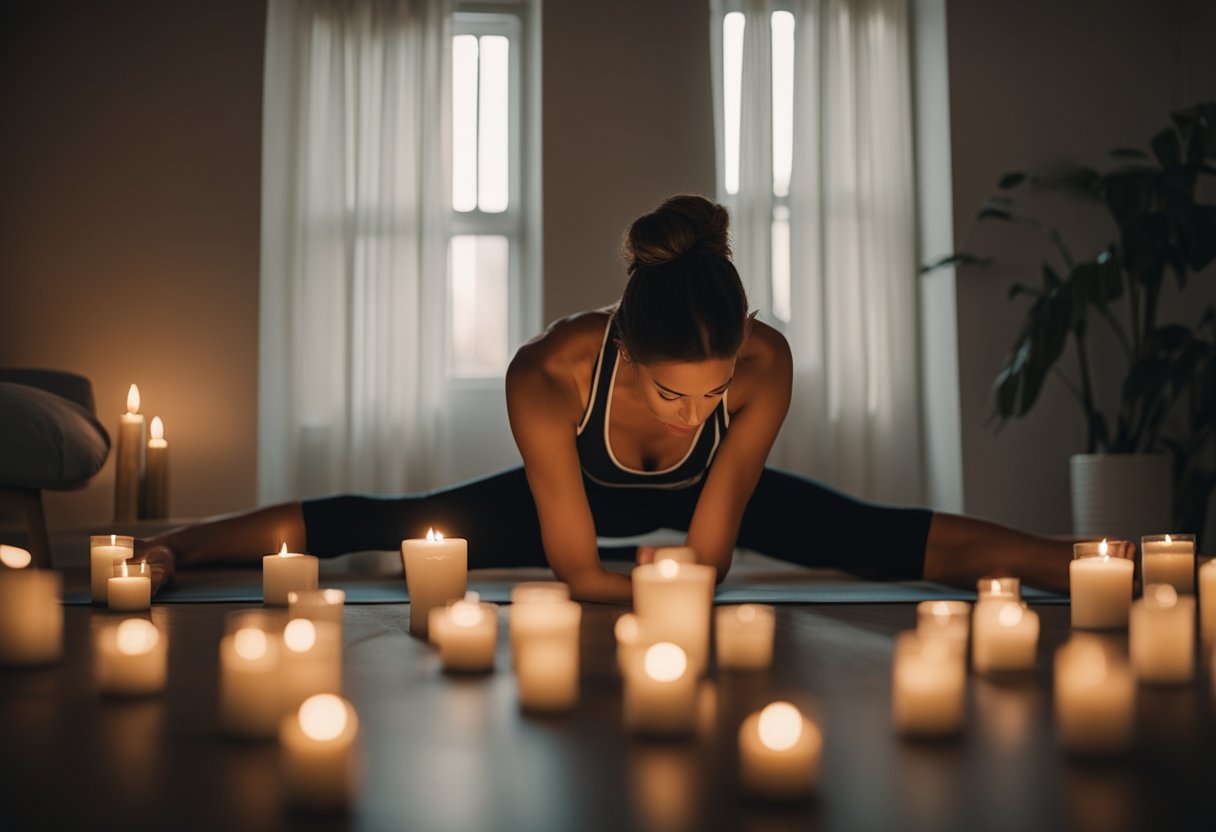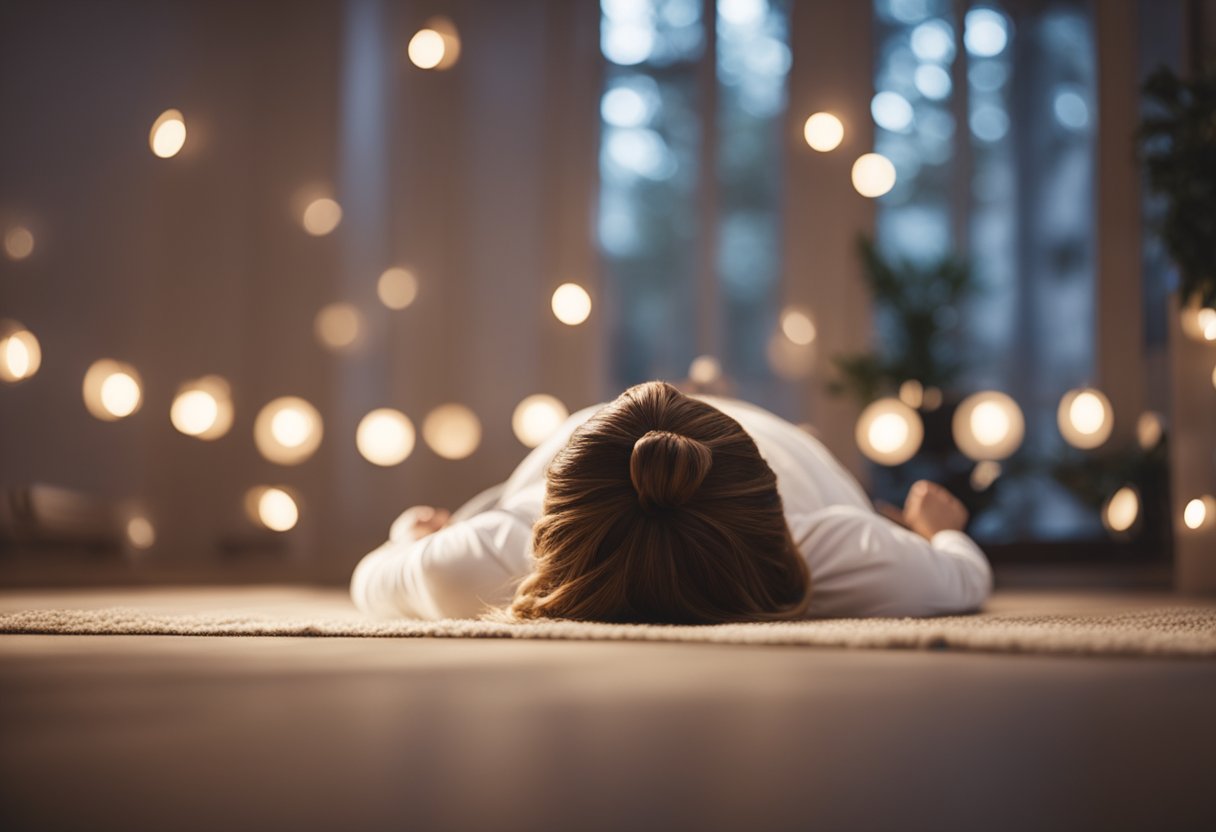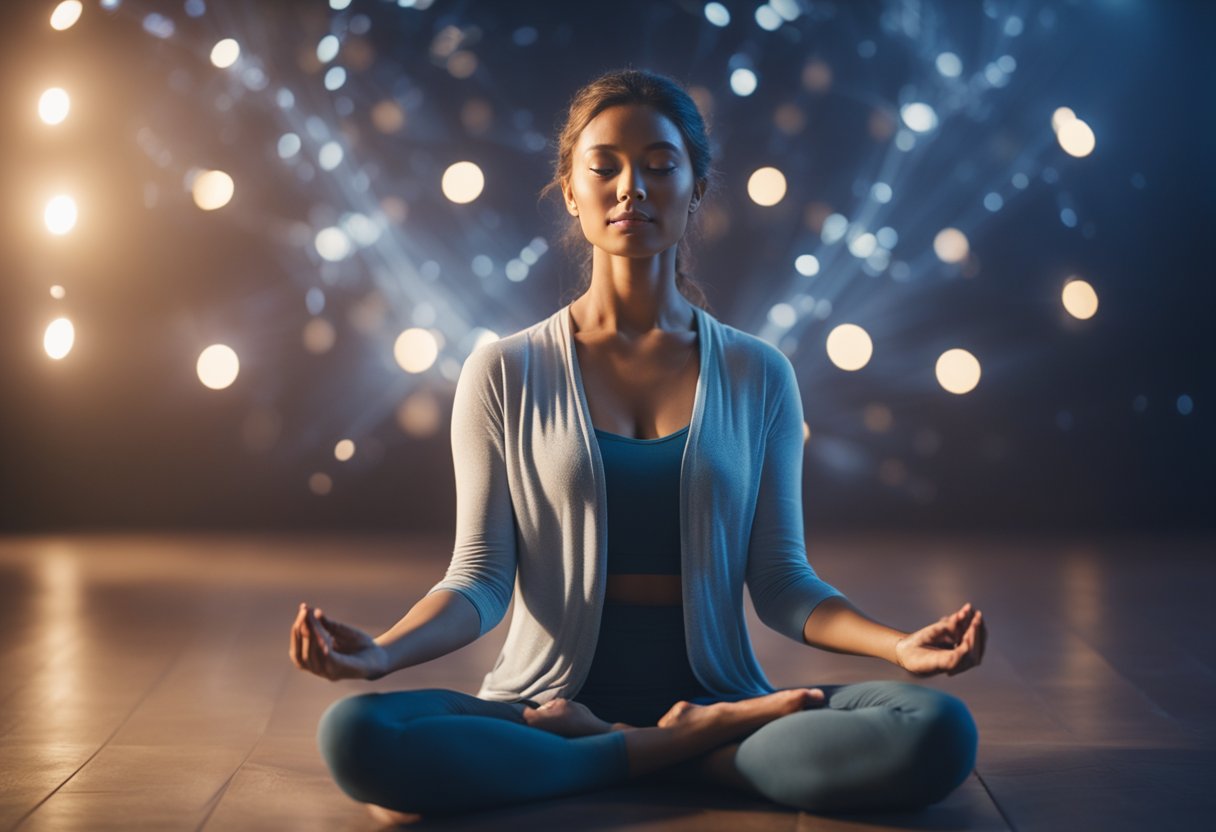Many people struggle with sleep issues, leading them to seek effective solutions. Yoga can be a powerful tool for improving sleep quality, and practices like Yoga Nidra provide specific benefits to help calm the mind and body. Engaging in these techniques before bedtime may enhance relaxation and prepare individuals for a more restful night.
Incorporating yoga into a nightly routine not only encourages physical relaxation but also helps improve mental clarity and emotional balance. Studies show that slow movements combined with focused breathing can positively affect sleep patterns, making it easier to unwind before bed.
By exploring different yoga techniques, individuals can find practices that support better sleep. Methods like Yoga Nidra can calm the mind and relax the body, which help people fall asleep faster and enjoy deeper and more restorative rest.
Key Takeaways
- Yoga can significantly improve sleep quality and relaxation.
- Yoga Nidra techniques are effective for calming the mind and body.
- Establishing a nightly yoga routine supports overall health and well-being.
- A supportive mattress enhances yoga’s benefits by aligning the spine and relieving pressure points which allows the body to relax and achieve deeper sleep.

Understanding Yoga Nidra
Yoga Nidra encourages deep relaxation and improved sleep by blending meditation and mindfulness techniques. This practice guides individuals into a calm state between wakefulness and sleep, which helps reduce stress and ease body tension.
What Is Yoga Nidra?
Often described as yogic sleep, this method leads participants through guided relaxation, breathing exercises, and visualization. It creates a restful state where the mind remains aware while the body relaxes and helps those who struggle with sleep.
History and Origin
Yoga Nidra has ancient roots in yogic traditions. Its origins can be traced back to the teachings of Swami Satyananda Saraswati in the late 20th century, although similar practices have been part of Indian meditation for centuries.
The term “Nidra” means sleep in Sanskrit, and the practice was developed as a means to access deeper states of consciousness. Traditionally, it was used for spiritual development and healing to emphasize the connection between the mind and body. Today, it is recognized globally as an effective technique for improving sleep and promoting relaxation.
The Science of Sleep and Yoga
Understanding the connection between sleep and yoga reveals how physical practices can improve rest. Research shows that adding yoga to a daily routine can enhance relaxation and lead to deeper sleep.
Physiology of Sleep
Sleep happens in cycles that include light sleep, deep sleep, and REM sleep. Each stage supports physical health and mental well-being. Deep sleep helps the body repair tissues, strengthen the immune system, and consolidate memories. Disruptions in this phase may increase stress and anxiety.
Yoga nidra can encourage deep sleep by guiding the mind into a relaxed yet aware state. This practice blends mindfulness with rest and promotes calmness and improved sleep.
How Yoga Affects the Mind and Body
Yoga helps reduce cortisol levels, which are linked to stress. Lower cortisol levels can improve both relaxation and sleep quality. Certain poses activate the body’s relaxation response and calm the nervous system. Gentle stretches and controlled breathing improve blood flow and ease muscle tension. Moreover, yoga nidra for sleep and anxiety breaks the cycle of restless thoughts that hinder restful sleep. This method helps in managing anxiety, making it easier to drift off.
Incorporating these practices can lead to a more serene sleep experience and promote a sense of well-being.

Health Benefits of Yoga Nidra
Yoga Nidra provides various health benefits by improving sleep and reducing stress. This practice is an effective tool for many seeking to improve their overall mental and physical well-being.
Yoga Nidra for Insomnia
For those struggling with insomnia, Yoga Nidra encourages deep relaxation and eases physical tension. By combining controlled breathing with guided imagery, it quiets the mind and prepares the body for rest. Practicing regularly may improve sleep patterns and reduce reliance on sleep aids.
Stress Relief and Emotional Balance
Yoga Nidra effectively lowers stress and anxiety by guiding individuals away from negative thoughts and into a state of calm. This practice reduces cortisol levels, which helps improve mood and increase emotional stability. Many describe feeling peaceful and clear-headed after each session, which supports better focus and decision-making.
Supporting Overall Well-being
Yoga Nidra enhances mindfulness and self-awareness, which can improve memory, focus, and emotional resilience. Developing these skills often leads to stronger relationships, healthier choices, and greater productivity. Including Yoga Nidra in your routine may help you achieve a more balanced and fulfilling lifestyle.

Yoga Nidra Techniques and Practices
Yoga Nidra helps achieve deep relaxation and restful sleep through specific poses, guided meditations, and self-practice techniques.
Yoga Nidra Pose and Posture
The typical pose for Yoga Nidra is Savasana (corpse pose), where you lie on your back with arms relaxed at your sides and palms facing upward. This position supports spinal alignment and promotes relaxation. Holding this pose for 30 to 40 minutes can deepen the benefits. Adding cushions or blankets may improve comfort.
Guided Yoga Nidra Meditation
Guided Yoga Nidra meditation often involves listening to an instructor who leads you through breath awareness, body scanning, and intention setting. These techniques help focus the mind and reduce distractions. Creating a calm environment with quiet surroundings, comfortable clothing, and an eye mask can enhance the experience.
Self-Practice Tips
Building a consistent routine improves self-practice. Begin with slow, deep breathing to quiet the mind, then follow steps such as posture, intention setting, and body awareness. Using recordings or scripts may help maintain focus. Exploring different styles of Yoga Nidra allows you to tailor the practice to your specific needs, whether for relaxation or addressing issues like insomnia.

Implementing Yoga Nidra Into Your Routine
Incorporating Yoga Nidra into a sleep routine can improve restfulness by promoting deep relaxation and better sleep quality. Here are essential tips on timing, environment, and techniques to maximize its benefits.
Best Time for Practice
The evening works best for practicing Yoga Nidra. Doing it about an hour before bedtime allows the body and mind to unwind and prepare you for a restful night. Some find it helpful after work to ease stress, while others prefer it right before sleep for a smoother transition.
Exploring different times may help you discover what suits you best. Staying consistent can train your body to relax more easily each night.
Creating a Conducive Environment
A tranquil space is important for Yoga Nidra. Dim lighting or candles can create a soothing atmosphere. Comfortable clothing and a soft mat or blanket improve relaxation. Maintaining a comfortable room temperature also enhances the experience.
Using calming scents like lavender or chamomile can promote deeper relaxation, while soft music or nature sounds may improve focus. A well-prepared space encourages better results during Yoga Nidra and supports restful sleep.
Incorporating Yoga Nidra Before Bed
To practice Yoga Nidra before bed, try following a guided session. Many apps and online resources provide helpful meditations for sleep. Lie comfortably on your back, focus on your breath, and release daily worries. Moving through body scan techniques encourages deeper relaxation. Visualization exercises can further calm the mind and guide you into sleep.
Practicing regularly can strengthen this routine and help Yoga Nidra become a valuable part of your bedtime habits.

Advanced Concepts in Yoga Nidra
Yoga Nidra introduces techniques that improve sleep quality by guiding practitioners into deep relaxation. Understanding its deeper concepts can enhance the benefits.
Deepening Your Practice
To improve your Yoga Nidra experience, focus on body awareness and breath control. Lying in a comfortable position allows the body to fully relax, which is important to achieving deep sleep. During practice, shift your attention to different body parts and mentally scan for sensations. This process releases tension and encourages calmness. Setting a regular practice time and creating a quiet environment can strengthen results. Soft music or guided meditation may deepen the experience.
Practicing consistently often leads to improved sleep quality. Techniques like visualization can further calm the mind. Imagining peaceful scenes prepares you for rest and promotes deeper relaxation.
Exploring the Sankalpa (Intention)
The Sankalpa serves as a guiding intention in Yoga Nidra. A simple and positive statement such as “I am calm” or “I rest deeply” can shape your experience and strengthen focus.
Incorporating the Sankalpa into the session can also positively impact sleep patterns. By reinforcing intentions, individuals may find themselves achieving deeper sleep. This may create a sense of peace that lingers beyond the practice.

Common Challenges and Solutions
Practicing yoga for sleep can come with challenges, but managing distractions and preventing drowsiness during routines can improve the experience.
Dealing With Distractions
Many struggle to focus during yoga due to noise, discomfort, or racing thoughts. Creating a calm environment can help:
- Choose a Quiet Space: Pick a spot with minimal noise, and consider soft music or nature sounds to block out disturbances.
- Comfort is Key: Use mats, cushions, or blankets to make your space cozy.
- Mental Preparation: Spend a few moments breathing deeply to calm your mind before starting.
For those learning yoga nidra, guided sessions can help maintain focus and encourage deeper relaxation. Adding elements like yoga meditation sleep may also enhance the calming effect.
Overcoming Sleepiness During Practice
Feeling drowsy can reduce the benefits of yoga or cause you to fall asleep too soon.
- Start Slowly: Begin with gentle stretches and poses to wake your body up gradually.
- Engage in Active Breathing: Deep, intentional breathing boosts energy while easing the mind.
- Try Yoga Nidra: This guided relaxation method combines focus with mindfulness and helps you stay aware while promoting restful sleep later.
By using these strategies, you can improve your yoga routine and create a better path toward restful, quality sleep.
Complementary Practices and Lifestyle Changes
In addition to yoga, certain lifestyle changes can improve sleep quality. Diet, nutrition, and relaxation techniques all help create an environment that promotes deeper rest.
Diet and Nutrition for Better Sleep
What you eat greatly influences sleep. Magnesium-rich foods like nuts and seeds can calm the nervous system, while tryptophan-rich options such as turkey and dairy may boost serotonin levels to support restful sleep.
Avoiding heavy meals near bedtime is important since they can cause discomfort and disrupt rest. Instead, a light snack that combines carbohydrates and protein, like whole-grain toast with peanut butter, may help you fall asleep more easily. Herbal teas such as chamomile or valerian root can encourage relaxation before bed. Staying hydrated throughout the day is essential, though limiting liquids close to bedtime can prevent sleep disturbances.
Additional Relaxation Techniques
Other relaxation methods can enhance yoga’s effects on sleep. Meditation is one effective option since spending a few quiet moments in mindful practice may calm the mind and reduce stress. Deep breathing exercises can also help. Techniques like the 4-7-8 method, which involves inhaling for four counts, holding for seven, and exhaling for eight, encourage the body to relax.
Creating a consistent bedtime routine signals the body that it’s time to wind down. Activities like reading or listening to calming music can promote relaxation. Limiting screen time before bed is equally important since blue light from devices can interfere with sleep quality.
How Mattresses Enhance Yoga for Better Sleep
Choosing the right mattress is important in improving the benefits of yoga for sleep. A supportive mattress keeps the spine aligned and relieves pressure points, which helps the body relax after yoga.
Key benefits of a quality mattress include:
- Support: Proper alignment reduces discomfort and promotes restful sleep.
- Comfort: Soft and breathable materials help you relax more easily.
- Temperature Control: Cooling features prevent overheating during the night.
According to experts, pairing yoga with a good mattress leads to enhanced relaxation. After a yoga session, a quality mattress helps maintain that peaceful state throughout the night.
The Helix Midnight Luxe mattress combines support and comfort, which is ideal for those who practice yoga to improve sleep. Its zoned support system reinforces the lower back and keeps your spine aligned to reduce pain and stiffness after stretching. Its memory foam layers conform to your body and ease pressure on areas like your hips and shoulders, which helps your muscles relax. The breathable cooling cover enhances airflow and regulates temperature to prevent overheating. This balanced design creates a restful space that promotes deeper and more refreshing sleep.
Incorporating yoga into a bedtime routine while using a supportive mattress can significantly contribute to improving sleep quality. As she stretches out on a comfortable surface, her body can fully relax and rejuvenate.

Conclusion
Yoga can be an effective way of improving sleep. Many people find that practicing yoga before bed helps them relax, which can lead to better sleep quality.
Yoga Nidra meditation is a popular practice. It aims to promote deep relaxation and awareness. This technique is useful for those struggling with sleep and anxiety. Incorporating yoga into a nightly routine has benefits. Simple stretches or breathing exercises can prepare the body for rest. Just a few minutes of stretching can ease tension in muscles.
For those interested in easing anxiety, using yoga can be beneficial. Mindful breathing and gentle poses create a sense of calm that can reduce racing thoughts that often interfere with sleep. Yoga Nidra is a guided practice that helps you reach a state between being awake and asleep. This deeply relaxing state can calm the mind and body, which makes it easier to drift off afterward.
Overall, integrating yoga into daily habits can support better sleep. Regular practice may lead to improved sleep quality and reduced anxiety. Employing these techniques can help anyone seeking a more restful night.
Frequently Asked Questions
Many individuals seek to enhance their sleep quality through yoga. This section addresses common inquiries about specific poses, techniques for managing insomnia, and how to create an effective bedtime routine.








